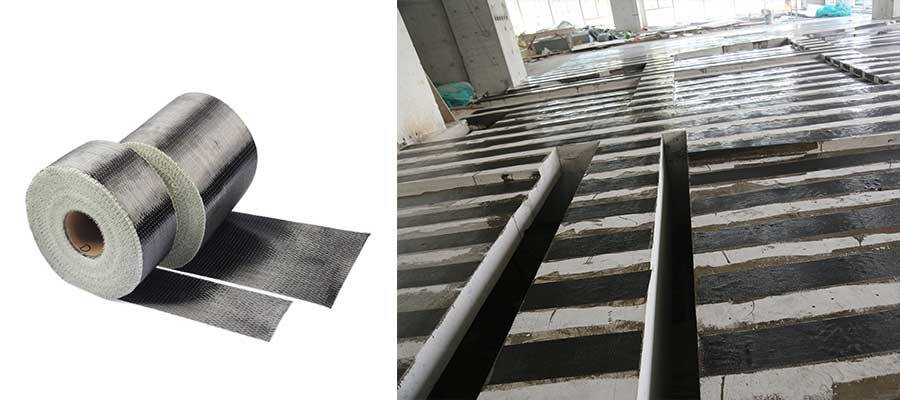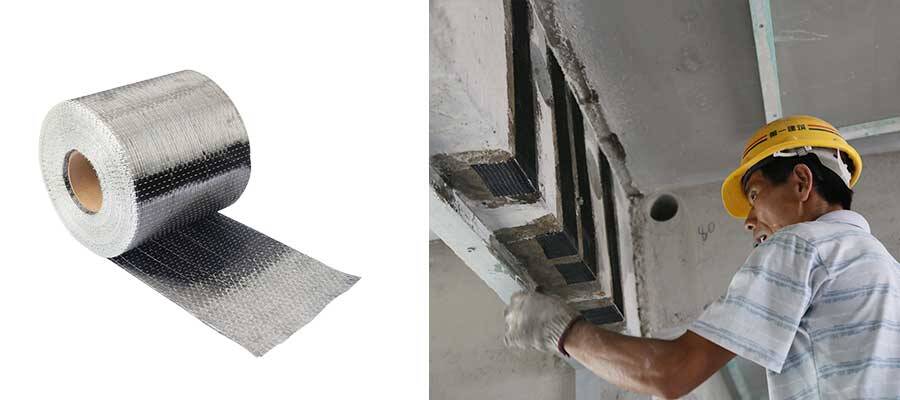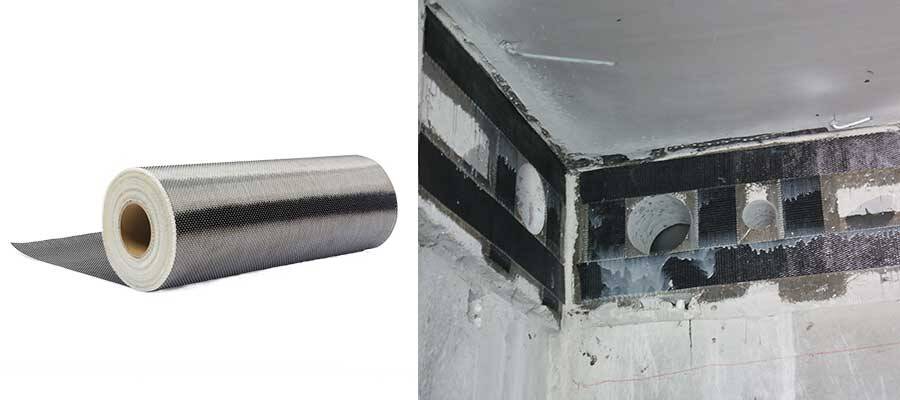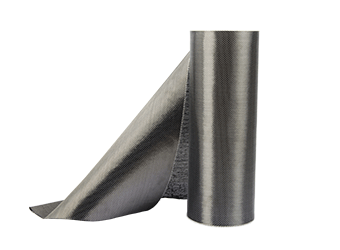Solutions
Horse Construction offers full range of structural strengthening materials with technical supports, documentation supports, products supports, project supports.
It is not long for China to introduce the technology of bonding carbon fiber to reinforce concrete. But this technology has been applied in more and more reinforcement projects. Its excellent performance is fully reflected in the reinforcement process of concrete structures.
With the development of material science, the application of fiber composite materials in civil engineering has become a hot research topic at home and abroad. Unidirectioanl carbon fiber fabric is an artificial high-tech material, which has excellent performance and stability. This material is suitable for the maintenance and reinforcement of concrete structures.

1 Characteristic of Carbon Fiber
Carbon fiber is a kind of fibrous carbon material. It is a high-tech material product manufactured by special technology under the high temperature of thousands of degrees. Carbon fiber materials have the advantages of aging resistance, high strength, light weight, corrosion resistance and extremely stable physical properties. Its tensile strength can reach 7-1O times of steel, but its proportion is less than 25% of steel. It is black filament, very small diameter, very easy to break, can not be used alone. Only after impregnating carbon fibers with resin and making them into composites with directional arrangement of fibers by special technology can they be applied. Generally, the finished sheet is divided into carbon fiber cloth and carbon fiber laminate. Carbon fiber sheet is more random than carbon fiber laminate.
2 Characteristics and Advantages of Carbon Fiber Reinforcement Technology
2.1. The chemical stability of carbon fibers is excellent. It can improve the adaptability of building structure to external environment and prolong the service life of building structure.
2.2. The physical and mechanical properties of carbon fiber materials are excellent. The excellent physical and mechanical properties of the material enable it to be effectively used in the strengthening engineering of flexural, shear, compressive, fatigue, seismic, wind, crack and deflection control of structures, and achieve excellent reinforcement effect.
2.3. Carbon fiber material is light in weight and high in strength. The structure strengthened by it can be decorated without leaving any reinforcement trace and affecting the external appearance of the structure. Its light weight and high strength make it possible to reinforce the structure without increasing the volume of the structure and changing the shape of the structure. This is a characteristic that other methods of maintenance and reinforcement can not be compared.
2.4. The construction procedure of strengthening concrete with CFRP is very simple and convenient. When it is in reinforcement construction, it does not need to use large-scale engineering equipment, only need to use small electric tools to operate. Therefore, it has the advantages of fewer types of work, less labor, shorter construction period and faster progress in construction. Because the construction of CFRP reinforcement technology is convenient and simple, it has great economic and social benefits, so the CFRP reinforcement technology is an ideal building material for strengthening concrete structures.

3 Reinforcement with CFRP
The continuous development and progress of building materials used in engineering practice and the emergence of new materials are important driving forces for the development of construction engineering. The research and development of new material carbon fiber and its successful application in the field of maintenance and reinforcement of construction projects have opened a new chapter in the reinforcement technology of construction projects.
3.1. Requirements for Carbon Fiber Materials
(1) Carbon fibre composites
Carbon fiber composites are composed of matrix and fibers. There are three kinds of fiber materials commonly used in strengthening concrete structures: aramid fiber, carbon fiber and glass fiber. The characteristics of these three composites are that they are completely linear elastic in stress and strain, and there is no yield point or plastic region in the material. When strengthening concrete structures with CFRP, it is required that CFRP be orderly bonded to the surface of members according to the structural stress and structural characteristics, so as to make use of the characteristics of CFRP to restrain structural deformation and improve the ultimate strength and load-bearing capacity of structures.
(2) Bonding materials
Whether carbon fiber cloth and concrete can work together is the key point of bonding material performance. Bonding material is also the key to the transmission of force between them. The bonding material we choose must have enough toughness. It will not cause brittle bond failure due to concrete cracking. At the same time, it must have enough strength and stiffness to ensure the transfer of shear force between carbon fiber and concrete. Because the construction environment of the concrete structure reinforcement project is not limited, the bonding material must be able to adapt to the harsh natural environment just like carbon fiber material.
3.2. Construction Technology and Requirements of CFRP Reinforced Concrete Structures
(1) Requirements for preparation and foundation treatment before construction
Before pasting carbon fiber cloth to concrete, it is required that the deteriorating layer on the surface of concrete structure be removed and polished by grinding wheel first: the dislocation and protrusion of the base surface of concrete structure should be smoothed, the corner part and protrusion part should be smoothed, the corner part should be chamfered, and the crack part should be repaired by injecting epoxy resin slurry. Cleaning of concrete base surface: first brush loose scum with steel wire brush, then remove dust with compressed air: then wipe the surface with acetone or anhydrous alcohol, or rinse with clean water, but it must be ensured that the concrete base surface is fully dry before the construction of the next process.
2) Construction requirements for pasting
A. Requirements for the foundation of concrete structures to be strengthened: CFRP reinforcement technology of concrete structures relies on the bonding efficiency between CFRP and the surface of the structure, so the strength grade of the concrete of the base should not be lower than C15. At the same time, the reinforced concrete structure is required to have a good protective layer, and the base surface is required to be flat. For the surface defects such as peeling, peeling, corrosion, cracks and serious carbonization of the structure, repair and construction must be carried out first.
B. Adhesion of CFRP: When strengthening concrete members with CFRP, it is required to adopt multi-layer bonding method of thin cloth to ensure full infiltration with bonding materials. For flexural members, it is better to reinforce them by placing CFRP along the axis of the tension zone, and to take necessary anchorage measures near the end of the section in the direction of the main fiber.
C. Overlap and truncation of CFRP: When bonding CFRP to reinforce concrete, because the bond stress between CFRP and concrete is mainly concentrated in the range of 10cm at the end, the bond failure is brittle, so when the CFRP must be overlapped, the overlap length must not be less than 10cm. The overlap part must avoid the maximum stress area of the component, and the overlap end must be flat and without warping.
D. Carbon fibre cloth and its matching bonding materials selected in the project must have the material inspection certificate and qualification certificate provided by the manufacturer.
3.3. Quality Control of Reinforcement Materials by Bonding Method
Key points to be strictly controlled in construction
(1) Proportion control of bonding materials
The mix proportion of bonding materials must be strictly controlled. It is the key link to ensure the quality and effect of bonding reinforcement. It is required to prepare materials strictly according to the mix proportion when mixing.
(2) Construction temperature control
Epoxy resin cures slowly at low temperature. Generally, it is chosen to be constructed directly at the temperature of L5 ~28~C. If construction is carried out at low temperature, heating and maintenance measures must be taken.
(3) Pressure required for forming should be maintained.
When strengthening concrete beams and slabs, most of them are carried out at the bottom of the beams and pasted from the bottom to the top. If the pressure is insufficient, the bond between concrete and concrete will not be close enough, which will cause the material of reinforcement layer to fall off, and will affect the effect of reinforcement.
(4) Paste control
In order to avoid the formation of voids or degumming, it is necessary to extrude and scrape the air bubbles. Otherwise, it will affect the reinforcement effect of concrete structures, resulting in poor bonding of some parts, resulting in the phenomenon of stress concentration in these parts during the use of concrete structures, causing the destruction of concrete structures.

Epilogue
It is not long for China to introduce the technology of bonding carbon fiber to reinforce concrete. But this technology has been applied in more and more reinforcement projects. Its excellent performance is fully reflected in the reinforcement process of concrete structures.
You can find anything here you are in need of, have a trust trying on these products, you will find the big difference after that.

High strength carbon fiber reinforced polymer (CFRP) strip / laminate / plate for structural strengthening and concrete repair

High strength, unidirectional carbon fiber fabric pre-saturated to form a carbon fiber reinforced polymer (CFRP) fabric used to strengthen structural concrete elements.

High strength, unidirectional carbon fiber sheet pre-saturated to form a carbon fiber reinforced polymer (CFRP) sheet used to strengthen structural concrete elements.